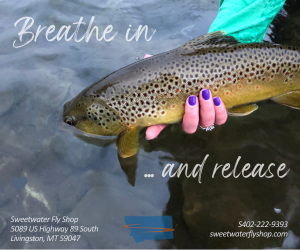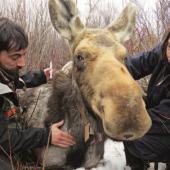Mistaken Identity
Deciphering southwest Montana’s most commonly confused fauna.
Correctly identifying species in the field isn’t always easy. There’s often something working against you—distance, lighting, angle of view, observation time, or lack of experience—to thwart your identification efforts. What’s more, being corrected by a friend or fellow observer can be embarrassing. We’ve all been there, but life’s all about learning from your mistakes. Thankfully there are plenty of heuristics to help differentiate one species from another. Read on, and soon you’ll be picking out even the most analogous animals with certainty.
Beaver vs. Muskrat
Beavers are seldom mistaken for other animals, though the same can’t be said for some of their fellow aquatic-mammals. Weighing between 30 and 60 pounds, beavers are much larger than similar species, which makes them easier to spot. They’re known to swim with their heads sloped backwards, the tip of their nose vertical to the surface, and their tails submerged until they dive.
Muskrats closely resemble beavers, though they’re much smaller. In the water, you’ll only see a muskrat’s back and naked, flattened tail on the surface. You can recognize these animals not only by their size, but by their tails when they swim, which they wave back and forth to guide and propel themselves.
Otter vs. Mink
Otters—with their long, slim bodies and muscular, furred tails—are also easily identified. Look for broad faces and the whiskered, somewhat blunt snouts. They swim in a fluid motion with their heads and backs above the surface, often diving and re-emerge in a “rolling” fashion.
Mink are smaller than otters (roughly two feet long), though they can appear similar in stature. Unlike otters, who are often found in water, mink are most commonly spotted on the shoreline. A small white dot on the tip of the lower jaw is a telltale sign of a mink, as is its long, skinny tail.
Bull (Gopher) Snake vs. Rattlesnake
Gopher snakes can be identified by their heads, which do not exceed the width of their necks. They have circular pupils, no pits between the eyes and nose, and pointed tails. When startled, they will occasionally mimic rattlesnakes by broadening their heads and rapidly vibrating their tails against the ground. Thankfully, they’re nonvenomous.
Rattlesnakes, however, are extremely venomous. They have vertically slit, “cat-eye” pupils, pits between the eye and nose, wide triangular heads, and the namesake rattles at the ends of their tails. When a perceived threat arises, they coil, rattle, and prepare to strike. If you hear a rattle, slowly back away and give ’em space—they can strike from any position and reach up to 2/3 their body length
Coyote vs. Wolf
Coyotes are roughly a third the size of wolves, and appear more delicate, but size can be tough to gauge from afar. Their tails are bushier than wolves’, and their heads and ears are more triangular. Their coats range from gray to tan to brown, and they often have rusty highlights on their ears and legs.
Wolves have a blockier body structure with a less-full tail. Their ears are rounder and are typically set apart by the width of the head. While mature wolves will tower over sagebrush, a coyote’s small stature often leaves it concealed in the shrub. The coat of a wolf can vary between shades of black, gray, brown, and white.
Eagle vs. Vulture
Bald eagles—at least mature ones—are easy to identify, but juveniles can be tricky. It takes five years for a juvenile to obtain the full adult plumage, so look for solid brown bodies mottled with white feathers. To avoid mistaking them for golden eagles, focus on location—bald eagles are more prevalent near rivers. They fly with their wings held flat, and their heads and necks protrude further from their “shoulders” than other species.
Golden eagles are commonly mistaken for turkey vultures. Look for solid brown bodies and the golden napes of their necks. Immature goldens will have white patches on the underside of their wings and white at the base of the tail. They will occasionally flap their wings while soaring and hold their wings in a soft “V” shape.
Turkey vultures’ heads and necks are much smaller than an eagle’s. They are easily identified by their pink, featherless heads. They hold their wings in a steep “V” during flight and seldom flap their wings when soaring.
Brook vs. Brown Trout
Brook trout are beautiful, colorful fish with distinct wavy lines across their backs and a white leading edge on their lower fins. Their flanks are covered with red spots surrounded by blue halos.
Brown trout have fewer spots on their backs and lack contrasting colors on their lower fins. Additionally, their flanks have dark spots—black, red, and orange are most common—often with white halos. In the hand, it can be easy to tell the two apart: a brown trout’s mouth is white inside, whereas a brook trout’s is black.
Ravens vs. Crows
Ravens and crows are closely related and very similar. However, ravens are much larger than crows, seek more solitude, and have a heavy bill with a hooked end. Conversely, crows are more social and have a slimmer, cone-shaped bill.
When in flight, observe the trailing end of the tail feathers. A raven’s feathers come to a point, while the end of a crow’s tail is less defined or almost straight across. Additionally, a raven’s voice is deeper than that of a crow.




























